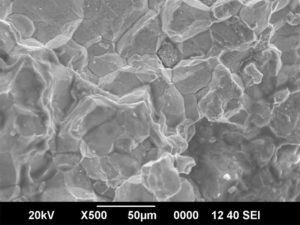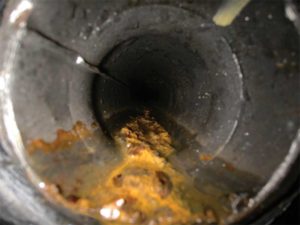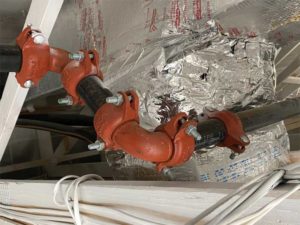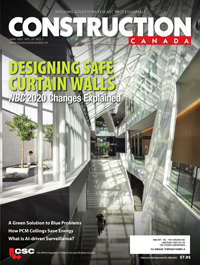Failures in plumbing pipe due to construction methods

As a result, leaks began to occur immediately downstream of bends in the pipe, which is where turbulence can be problematic at high fluid velocities. On sectioning the leaking pipe samples in their laboratory to inspect the interior condition, the authors’ company found the protective scale was eroded away at the leak location and observed horseshoe-shaped pits oriented in the direction of the water flow (See images 1 and 2). This internal condition is typical of erosion-corrosion.
The authors’ company advised the building owner to replace the 12.7 mm (0.5 in.) diameter return pipe with the original 19 mm (0.75 in.) size. This failure demonstrated it is unwise to conduct modifications to a plumbing system without engineering review.
Stress corrosion cracking of copper pipe
Copper is susceptible to a failure mechanism known as stress corrosion cracking, where a combination of tensile stress and corrosive liquid (e.g. ammonia) results in intergranular cracking of the copper microstructure. Flexible copper tubing is particularly susceptible to this mechanism. When flexible tubing coiled for packaging is uncoiled for installation, permanent stresses develop. If the tubing is exposed to a corrosive environment, premature failure due to stress corrosion cracking can occur.

Flexible copper tubing conforming to ASTM B280, Standard Specification for Seamless Copper Tube for Air Conditioning and Refrigeration Field Service,2 is used in HVAC systems for the transfer of a refrigerant, such as glycol, between a compressor and a heat exchanger. Although chilled copper lines typically develop an external corrosion patina due to condensation in a humid environment, no significant section loss occurs. However, copper tubing in a stressed state can fail if exposed to certain environments.
The authors’ company was engaged in a project where HVAC lines in a newly built apartment complex had developed leaks. During the construction of this wood-framed building, an extreme weather event had resulted in the wetting of the building’s interior frame. In the subsequent months, mould grew on these wood surfaces, leading to the implementation of a mould-abatement program. The manufacturer’s literature indicated the mould abatement chemicals were compatible with copper, so there should have been no corrosion issues. However, when the HVAC units were activated upon completion of the building, multiple leaks were discovered.
The HVAC lines in this building consisted of an uninsulated liquid line, bundled with a foam-insulated vapour line, held together at regular intervals by adhesive tape (See image 3 on page 39). A laboratory analysis determined discrete cracks had formed in the uninsulated liquid line at locations where the tape was present (See image 4). Metallographic and fractographic analysis confirmed the failure mechanism as stress corrosion cracking (See image 5). The authors’ company conducted experiments to demonstrate how the exposure of the tape and foam insulation to the mould-remediation chemicals resulted in the production of ammonium ions, which generated ammonia.
The HVAC copper lines in the building were replaced. This failure demonstrated caution should be used in spraying chemicals in a building containing plumbing piping, even if the data sheets suggest the materials are compatible. Temporarily wrapping exposed piping prior to spraying chemicals would be a prudent approach.
Internal corrosion of steel sprinkler pipe

Wet fire suppression systems, consisting of steel piping conforming to ASTM A135, Standard Specification for Electric-Resistance-Welded Steel Pipe, are normally resistant to internal corrosion. This is because electrochemical corrosion reactions typically require oxygen, and dissolved oxygen in the water standing in sprinkler pipes is quickly consumed, and corrosion is suppressed. However, fire suppression piping exposed to potential freeze conditions requires the use of dry sprinkler systems, where the pipes are charged with compressed air rather than water.
Whereas wet sprinkler systems are filled with water and contain a finite amount of dissolved oxygen, dry sprinkler systems, which often contain inadvertent small quantities of water, can rapidly corrode, as there is an infinite amount of oxygen available for the electrochemical reaction. Standing water can collect in dry systems from the condensation of humid compressed air or from the accumulation of residual water from alarm testing. To combat this, fire codes such as National Fire Protection Association (NFPA) 13—Standard for the Installation of Sprinkler Systems—which is referenced by the National Fire Code of Canada (NFC), typically require dry sprinkler pipes to be sloped at a pitch of at least 6.3 mm (0.25 in.) per 3 m (10 ft) of pipe length towards a drain. An experienced mechanical contractor will know how to install a properly pitched dry sprinkler system.

The authors’ company investigated a project where significant internal corrosion of a dry sprinkler system developed after only three years of service (See image 6 ). The sprinkler pipes were located in an unheated attic space, and it included ductwork for a HVAC system to be installed after the sprinkler pipes. When checking the sprinkler pipe pitch, they encountered local runs of pipe which were back-pitched, preventing water drainage and resulting in advanced corrosion. Upon further investigation, it was found that in order to accommodate duct installation, the pipe hangers were adjusted and the pipe position was altered, causing back-pitch of the sprinkler pipe at several locations (See image 7 ).







